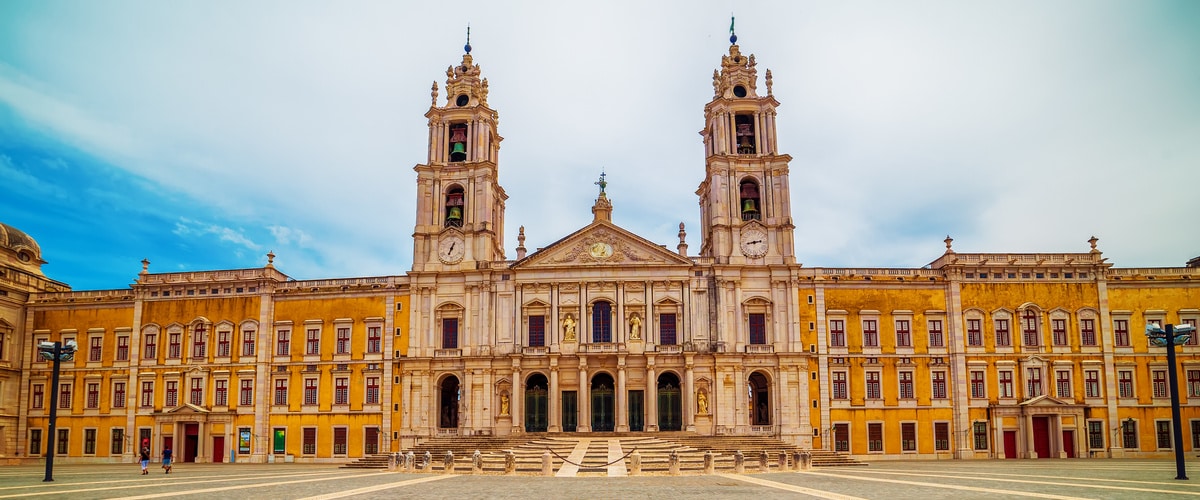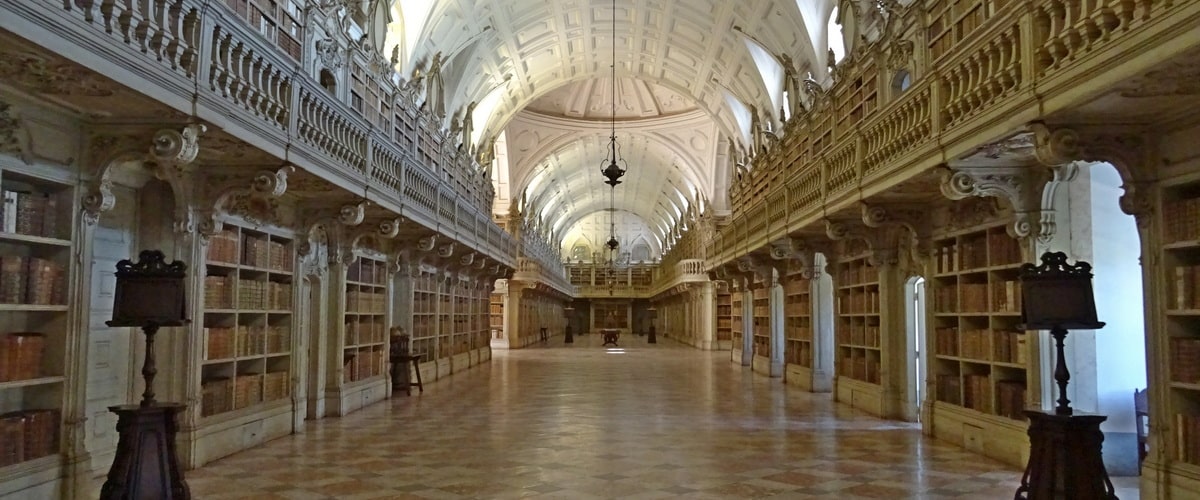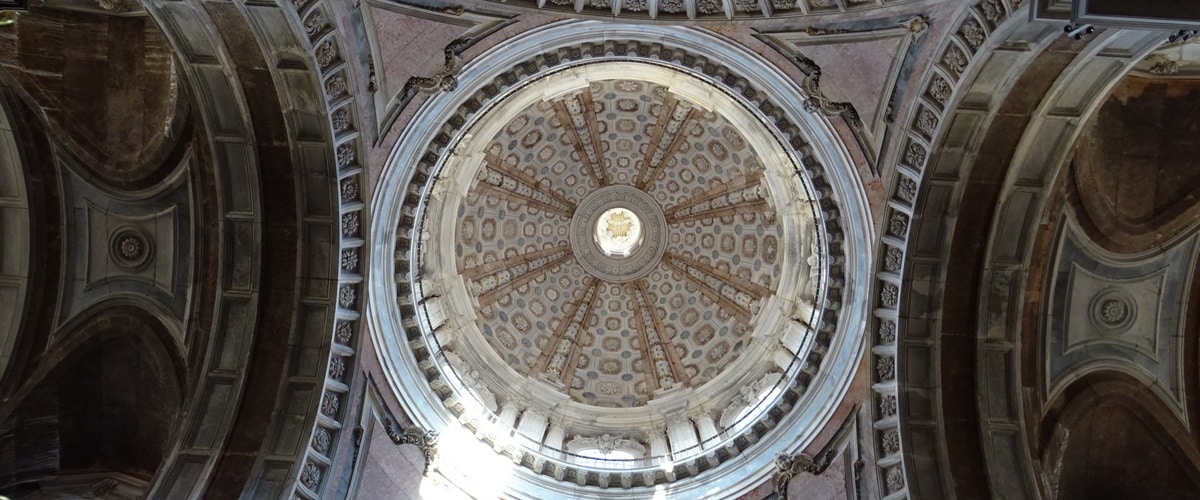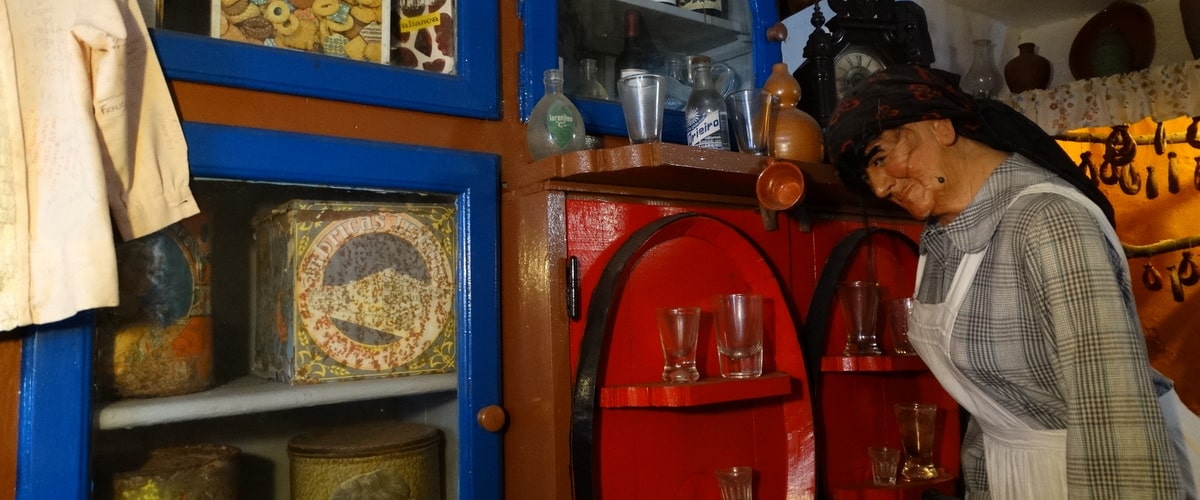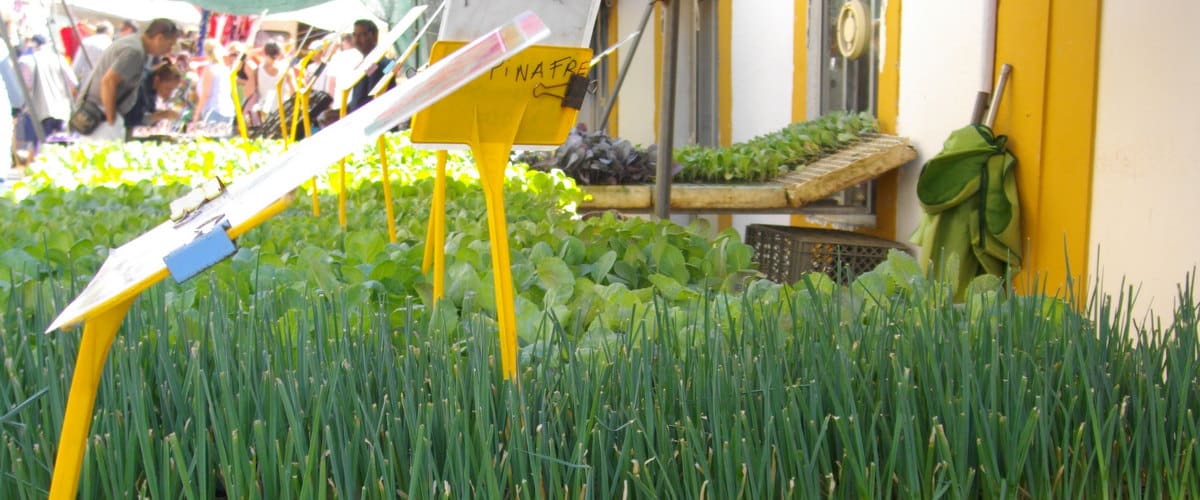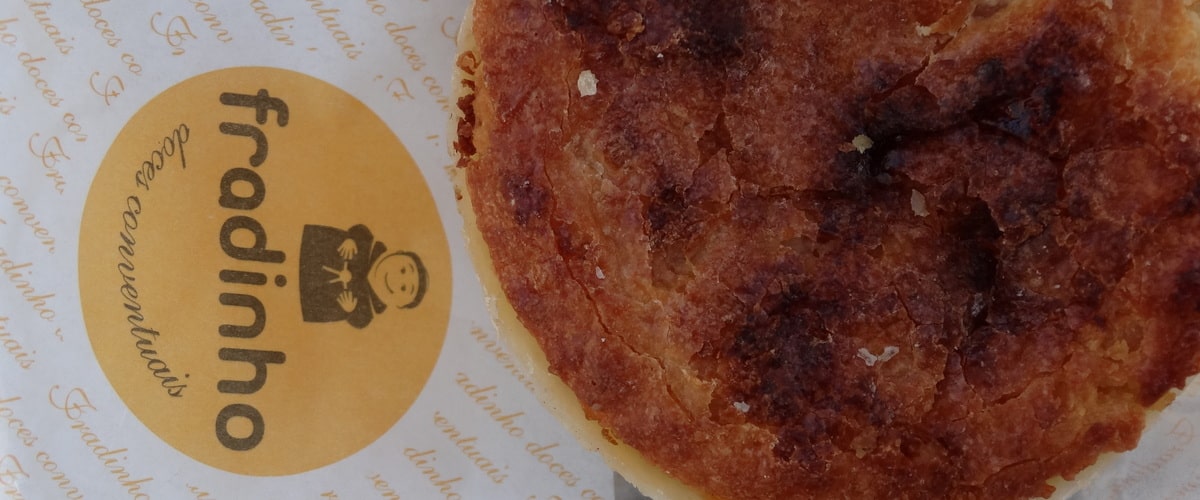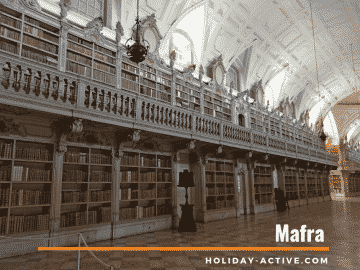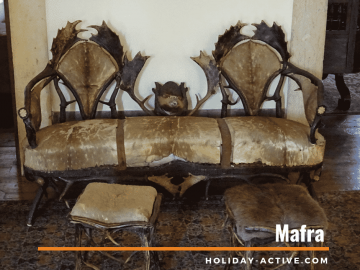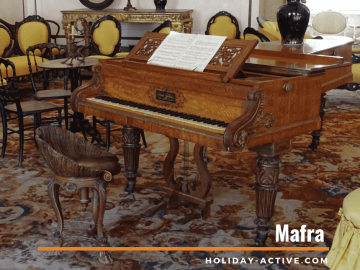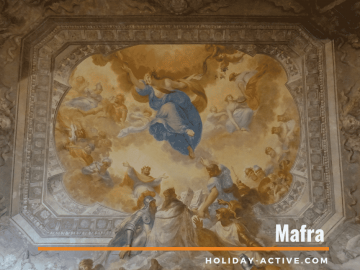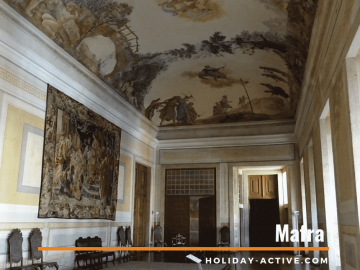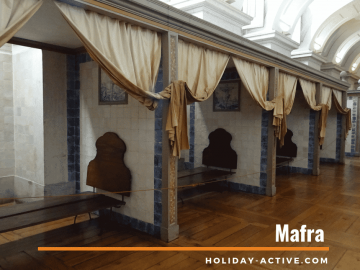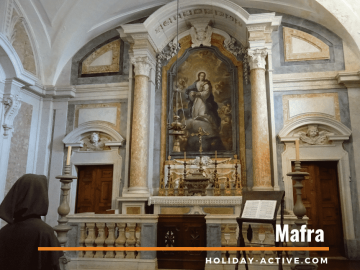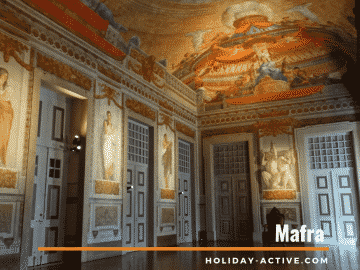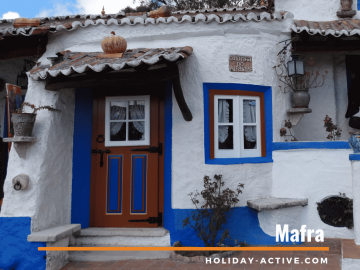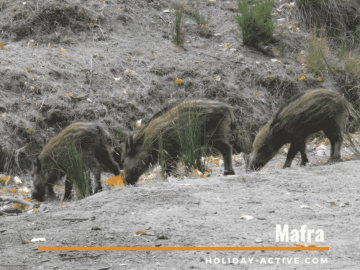Mafra
Mafra is 40km from Lisbon and a good option for a day trip from Lisbon
Located in the so-called “saloia” region, farmland on the outskirts of Lisbon that supplied the city with fresh produce. Known for its imposing Palace – Convent of Mafra that was immortalized by the novel Baltasar and Blimunda (Portuguese: Memorial do Convento) written by the Nobel Prize-winning Portuguese author José Saramago.
What to visit in Mafra
National Palace of Mafra
The Palace of Mafra with its famous corrilions, composed of 102 bells, can be seen from afar and is an unforgettable landmark of the village.
The Palace- Convent was built by D. João V in the first half of the 18th century, in fulfilment of a vow for an heir from his marriage to Queen D Maria Ana of Austria. After three years of marriage and still without children, he promised, the Franciscan Friars, a convent in Mafra, if his prayers for a succession line came to fruition, which happened with the birth of Princess Maria Bárbara, followed by 5 legitimate siblings
João Frederico Ludovice, goldsmith and German military engineer was appointed to undertake the mission. The initial project foresaw a convent for 30 Franciscan Friars but rapidly expanded to receive 300. In fact, it developed such as to embrace a Franciscan Convent, a Basilica and 2 Palaces, one destined to the king another to the queen connected by a 232m corridor.
The first stone was laid in 1717. Construction rapidly grew, masterfully moulded to an imposing monument, the work of 45,000 labours and fed with gold from Brazil. The Basilica of pure Italian Baroque style was inaugurated on the 22nd of October 1730, a Sunday and D João V birthday.
D. João V ensured the Convent’s upkeep, guaranteeing its housekeeping expenses which consisted of an annual expense of 120 barrels of wine, 70 barrels of olive oil and 600 heads of cows. Each friar received on Christmas and St. John’s day (S. João) his “extra” of 2 habits per friar, burel cloth and tobacco.
The story goes that there was a general embarrassment on how to pass onto the king the price of the carillon, which was considered too expensive for the time, especially for a country as small as Portugal. D João V, one of the richest monarchs of his time, took offence at the possibility of not having the financial means to buy it, so he ordered two.
D João V did not measure means decorating his Mafra Palace hiring the best and most exquisite Italian and Portuguese masters, of that time
However, the court life of D João V in Mafra did not enjoy great longevity given the death of the monarch in 1750.
His successor D João VI, installed himself and his court in Mafra during 1806-1807, when he then left rapidly for Brazil to escape the invasion of Napoleon Bonaparte. The French troops settled, majestically, in the palace, being replaced by the English troops that remained there until 1826.
The palace was never a permanent residence of the Royal Family, although it was used for various celebrations and during the hunting season, in the Tapada.
It was in the south tower that the last king of Portugal, D. Manuel II, spent his last night, from 4 to 5 October 1910, before leaving for exile when the Portuguese Republic was established.
The Palace – Convent of Mafra, though lesser known on the tourist circuit deserves your visit. With 1200 divisions that rival in beauty and grandeur: The pharmacy, destined for preparation and storage of medicines; the Diana Room with the goddess painted on the ceiling; the Throne room; the North Tower, king’s quarters; the South Towers, the queen’s room an the hunting room where all the furniture is made with animal horn from the animals still present today in the Tapada.
The Library of the National Palace of Mafra
The National Palace of Mafra has one of the most beautiful and complete libraries in the world. With a valuable collection of 36 thousand volumes dating from the 15t-18th centuries, on topics as diverse as theology, canon and civil law, history, geography, mathematics, art, music and medicine. In addition to an important collection of rare bibles
Pope Benedict XIV, in 1754, granted the king of Portugal permission to include in his collection the books prohibited by index (index of books censored by the Inquisition).
The library also houses a colony of small bats, active protectors of these works of art, by feeding on the invading insects
It is said that it was in this library that D. Miguel and the future D. Pedro IV learned to roller skate, as children.
The Infirmary at the Mafra Palace, a 16-bed ward
The Mafra National Palace has an infirmary with 16 beds that were intended for the severely ill. Nurse – friars took care of these patients who were visited daily by doctors and bleeders.
Attached to each bed was the doctor’s prescription so that it could be followed by patients and caregivers.
The special bed arrangement allowed them to be easily dragged onto the central corridor so that patients could follow the religious service held by the altar, at the far end of the corridor.
Each room comprised of a bed, a table with a drawer, a clothes hanger, a seat for the visitors and in a wall recess, a potty.
The Basilica
The Basilica forms the central axis and is part of the physiognomy of the Convent Palace of Mafra, flanked by the bell towers.
Conceived in the Italian baroque style by Ludovice it was made with the regional stone of liós. The 5m high dome was the first to be built in Portugal. Also of note are the 6 organs, which are unique throughout the world. If you have an opportunity it is worth listening to them.
You may also like to see
The Tapada de Mafra (Mafra Forest)
The Tapada de Mafra (Mafra Forest), created in 1747 has always been connected to the Palace and the hunting grounds for the King and its Court
Mafra, because of its proximity to Lisbon and its Court, constituted, together with Salvaterra de Magos, a privileged hunting area for the kings and queens of the House of Bragança, namely D. João V and D. José I, as well as D. Maria I and D. João VI, D. Pedro II, D. Fernando, D. Luis and D. Carlos.
Nowadays the Tapada de Mafra is a place of choice for family weekend trips and environmental education
Here, at the Tapada you may see deer, wild boars, foxes, wild rabbits, badgers, weasels and hedgehogs. The route can be done on foot following one of several marked tracks, by bicycle, on horseback, in a carriage or on the tractor train that crosses the grounds.
You can also watch the birds of prey show, many recovered by the Tapada centre itself. Learn everything there is to know about beekeeping and try out other activities such as archery, picnics and birdwatching.
There is also a Museum of Coaches and Carriages in the Tapada, open to visitors during guided tours and D Carlos’ hunting pavilion, where the Royal Family rested in between the long hours trailing their prey
A different day in touch with nature, that will stay forever in your and your children’s memory
José Franco Village Museum
A typical Portuguese miniature village created by the hands of the master potter José Franco
In Sobreiro, a village that lies between Mafra and Ericeira you will find, the Village Museum Jose Franco, a miniature village that will delight children and adults alike. Homage to the way of life of the local people.
With full-size replicas of the old workshops and shops, living spaces, decorated and equipped with the original objects of past times.
There is nothing lacking in this charming village: carpentry, the blacksmith shop, a grocery store, a tasca (pub), the school, the barber or dentist and other stores or workhouses for the various activities associated to the farm life of the Mafra region.
You will also find the small miniature villages, moulded in clay by José Franco. Small villages that look like cribs, with quaint cottages and rural figures driven by water or electricity. José Franco depicted the fishing village of Ericeira as well as the day to day life in a rural village, in all its detail and authenticity.
It also has a children’s playground and a bakery where you can taste the delicious bread with chorizo, freshly baked
Malveira Market
Malveira, also known as Malveira dos Bois, is a rural parish in the municipality of Mafra. With a long agricultural history and fertile land it supplied the region of Lisbon with fresh produce
The famous Malveira Market is held Thursday and is one of the oldest fairs in the country. Initially trading in cattle, today it sells all types of products: Tools, vegetables, poultry, bread and regional cakes, cheeses and sausages, clothes and furniture.
Therapy to the senses. The smell of earth and freshly picked fruit, the irresistible vernacular that makes you smile
What to taste
The Fradinho – A traditional Mafra sweet made of egg, almond and bean. Sold in the pastry store with the same name.
The unforgettable Mafra bread. Served hot with melting butter is definitely one of the simple things of life that comfort and delight
If you like game dishes, pay a visit to the Sete Sóis restaurant that serves deer, wild boar, pheasants and partridges
You may catch a Bus to Mafra. However, the number of buses are few so it is best to hire a car. 45 minutes will get you from Lisbon to Mafra
Handpicked Tours in Mafra
Portugal is rich in beautiful monuments. Majestic sites that impress the eye. But if you knew the historical facts that led to their constructions and inside stories hidden within, many would leave you aghast. Book a tour to Mafra and be gobsmacked.
Enjoy Portugal with holiday-active.com and make the most of your holidays in Mafra
Where to stay in Mafra? Our Suggestion
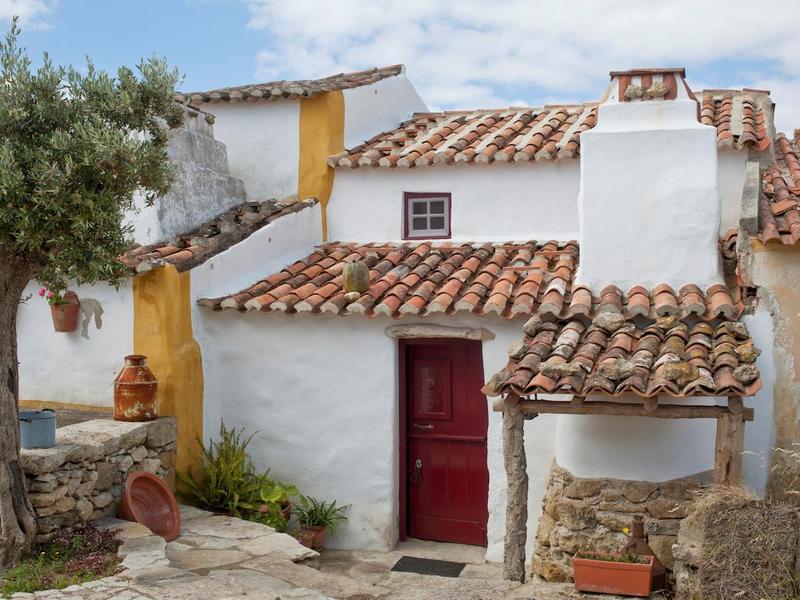
Aldeia da Mata Pequena
A aldeia da Mata Pequena is a small rural village that has been restored with love and tender care. A charismatic village with small details that enchant. Perfect to relax, great for kids.

Quinta dos Machados- Nature, love & relax
Quinta dos Machados is a historic property with 4 centuries of history, surrounded by 11 hectares, and remodelled with your well-being in mind: Spa with sauna, Turkish bath, hot tub, fitness room, swimming pool and even a sensory path in the middle of nature to awaken the senses. You may also sign up for various workshops such as breadmaking
Offers apartments and rooms

 English
English

